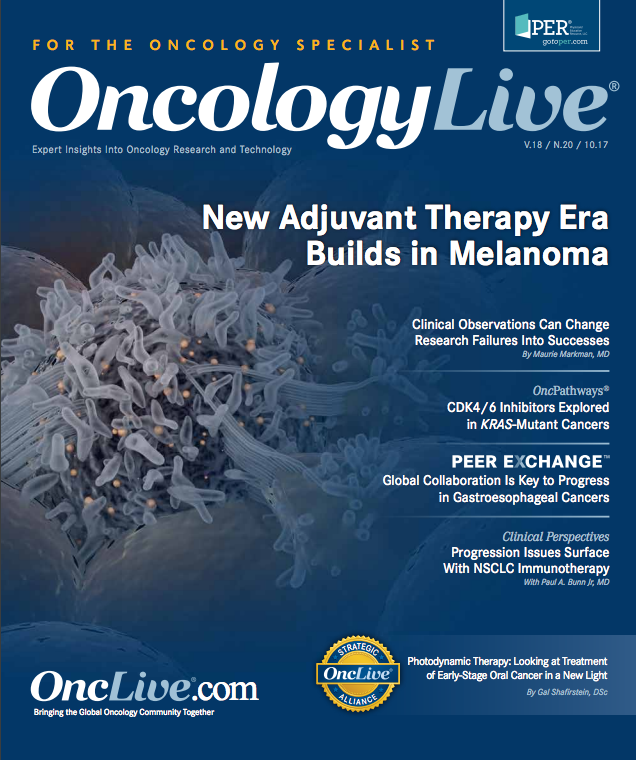Publication
Article
Oncology Live®
Photodynamic Therapy: Looking at Treatment of Early-Stage Oral Cancer in a New Light
Author(s):
Although surgery and radiotherapy are standard treatment modalities for grade T1/T2 oral cavity cancer, both approaches have well-documented limitations, including their association with adverse effects that lower quality of life for patients.
Gal Shafirstein, DScD

Member and Professor of Oncology,
Department of Cell Stress Biology
Director, Photodynamic Therapy Clinical Research
Roswell Park Cancer Institute
Buffalo, New York
Although surgery and radiotherapy are standard treatment modalities for grade T1/T2 oral cavity cancer (OCC), both approaches have well-documented limitations, including their association with adverse effects that lower quality of life (QoL) for patients.
Surgery for these tumors often requires removal of functional tissue, which can affect speech and swallowing, and the risk of local recurrence following surgery is as high as 20%.1-3 The adverse events (AEs) associated with radiation therapy, such as xerostomia, chronic dental decay, and risk of mandibular osteonecrosis, remain long after the patient is “cured.”4 The long-term nature of these AEs is of particular significance for younger patients, in whom the incidence of OCC is rising and who may have more at stake in terms of QoL.4,5
How PDT Works
Figure. Major Components of the PDT Process6
PDT for Early-Stage Head and Neck Cancer
For these reasons, it is important to consider alternative frontline therapies with less impact on QoL, such as photodynamic therapy (PDT), which has emerged as an attractive option for treating patients with early-stage OCC.Developed at Roswell Park Cancer Institute in the late 1970s, PDT is an FDA-approved treatment for early-stage lung cancer and palliation of late-stage lung cancer. It involves the generation of reactive oxygen species and radicals through light activation of photosensitizers administered intravenously a few hours to 4 days prior to treatment (Figure). PDT can be administered before or after surgery, chemotherapy, or radiation, without lowering the strength of the response to these therapies.6 At Roswell Park, PDT is offered as a treatment option for nonmelanoma skin cancer, lung, and esophageal cancers, as well as Barrett’s esophagus and other precancerous conditions.Numerous studies over the past 25 years have demonstrated the safety and efficacy of PDT in the treatment of early-stage oral and oropharyngeal carcinomas. Between 1990 and 2013, 729 patients were treated with PDT with a cumulative overall tumor response rate of 85%. Patients whose cancer did not fully respond to PDT and who underwent secondary treatment with either surgery or repeated PDT showed 100% complete response. The AEs of PDT are largely limited to photosensitivity and pain at the treatment site, which is easily managed by analgesics. Photosensitivity, which generally manifests as mild to moderate edema, can be limited through patient education and temporary avoidance of prolonged sun exposure.
Importantly, several studies have shown that PDT of OCC results in less treatment-associated morbidity than do conventional therapies, including little to no nerve damage, minimal scarring, and retention of organ function.7-11
Current Clinical Investigations
Although no direct-comparison studies exist, single-site and retrospective studies have compared responses after PDT with outcomes post surgery in early-stage oral cancer. Karakullukcu et al12 found no significant difference in treatment outcome between PDT (n = 55) and surgical removal (n = 43) of T1 to T2 oral cancer. A multicenter, retrospective meta-analysis of 126 PDT and 56 surgical T1 cases demonstrated a comparable complete response, and no significant differences in overall survival were observed between the 2 modalities.13 The breadth of experience in treatment of early-stage oral cancer with PDT suggests that early oral malignancies are amenable to this noninvasive therapy and that it can result in outcomes that are comparable to those of the standard of care.For the past 22 years, the team from the Photodynamic Therapy Center at Roswell Park has successfully competed for grant funding from the National Cancer Institute (NCI) to enhance our efforts to bring PDT to the clinic. The PDT Center developed a second-generation photosensitizer (HPPH) that is associated with short-term photosensitivity (7-14 days) and was found to be safe, with promising outcomes, in the treatment of early-stage oral cancer in a phase Ib study.11
Based on the data from this extensive NCI-supported research, Roswell Park has launched a multicenter, randomized phase II study to compare standard-of-care surgery with PDT with HPPH in patients with T1/T2 N0 oral cancer. The study is currently open for enrollment and will be conducted at Roswell Park Cancer Institute (RPCI), the University of Rochester, and the University of Minnesota (NCT03090412). The clinical study at RPCI is led by Hassan Arshad, MD, of the Department of Head and Neck Surgery/Plastic and Reconstructive Surgery. The study will assess rate of tumor response at 24 months as a primary endpoint and change in QoL as a secondary measure.
The OCC trial is 1 of several active Roswell Park studies incorporating PDT. We also have a randomized phase II trial of radical pleurectomy in combination with chemotherapy for epithelioid malignant pleural mesothelioma (NCT02153229), as part of an NCI-funded program project (P01CA183236) led by the University of Pennsylvania, and a phase I study of intraoperative PDT following surgery in patients with early stage non—small cell lung cancer (NCT01854684).
We are excited about what we’ll learn through these investigations and eager to find out whether these novel approaches can compare favorably to current standard treatments. Given the significant and longterm QoL impacts that often attend treatment for oral, head, and neck cancers, we are encouraged by the promise of expanding this precisely targeted treatment approach to more patients with cancer.
References
- Ganly I, Goldstein D, Carlson DL, et al. Long-term regional control and survival in patients with “low-risk,” early stage oral tongue cancer managed by partial glossectomy and neck dissection without postoperative radiation: the importance of tumor thickness. Cancer. 2013;119(6):1168-1176. doi: 10.1002/cncr.27872.
- Maxwell JH, Thompson LD, Brandwein-Gensler MS, et al. Early oral tongue squamous cell carcinoma: sampling of margins from tumor bed and worse local control. JAMA Otolaryngol Head Neck Surg. 2015;141(12):1104-1110. doi: 10.1001/jamaoto.2015.1351
- Shim SJ, Cha J, Koom WS, et al. Clinical outcomes for T1-2N0-1 oral tongue cancer patients underwent surgery with and without postoperative radiotherapy. Radiat Oncol. 2010;5:43. doi: 10.1186/1748-717X-5-43.
- Thomas L, Moore EJ, Olsen KD, Kasperbauer JL. Long-term quality of life in young adults treated for oral cavity squamous cell cancer. Ann Otol Rhinol Laryngol. 2012;121(6):395-401. doi: 10.1177/000348941212100606.
- Túri K , Barabás P, Csurgay K, Léhner GY, Lőrincz A, Németh ZS. An analysis of the epidemiological and etiological factors of oral tumors of young adults in a Central-Eastern European population. Pathol Oncol Res. 2013;19(3):353-363. doi: 10.1007/s12253-013-9628-y.
- Agostinis P, Berg K, Cengel KA, et al. Photodynamic therapy of cancer: an update. CA Cancer J Clin. 2011;61(4):250-281. doi: 10.3322/caac.20114.
- Hopper C, Kübler A, Lewis H, Tan IB, Putnam G. mTHPC-mediated photodynamic therapy for early oral squamous cell carcinoma. Int J Cancer. 2004;111(1):138-146. doi: 10.1002/ijc.20209.
- Biel MA. Photodynamic therapy of head and neck cancers. Methods Mol Biol. 2010;635:281-293. doi: 10.1007/978-1-60761-697-9_18.
- Volgger V, Betz CS. Photodynamic therapy in the upper aerodigestive tract. Overview and outlook. J Biophotonics. 2016;9(11-12):13021313. doi: 10.1002/jbio.201600036.
- Copper MP, Tan IB, Oppelaar H, Ruevekamp MC, Stewart FA. Meta-tetra(hydroxyphenyl)chlorin photodynamic therapy in early-stage squamous cell carcinoma of the head and neck. Arch Otolaryngol Head Neck Surg. 2003;129(7):709-711. doi: 10.1001/archotol.129.7.709.
- Rigual N, Shafirstein G, Cooper MT, et al. Photodynamic therapy with 3-(1’-hexyloxyethyl) pyropheophorbide a for cancer of the oral cavity. Clin Cancer Res. 2013;19(23):6605-6613. doi: 10.1158/1078-0432.CCR-13-1735.
- Karakullukcu B, Stoker SD, Wildeman AP, Copper MP, Wildeman MA, Tan IB. A matched cohort comparison of mTHPC-mediated photodynamic therapy and trans-oral surgery of early stage oral cavity squamous cell cancer. Eur Arch Otorhinolaryngol. 2013:270(3):10931097. doi: 10.1007/s00405-012-2104-6.
- de Visscher SA, Melchers LJ, Dijkstra PU, et al. mTHPC-mediated photodynamic therapy of early stage oral squamous cell carcinoma: a comparison to surgical treatment. Ann Surg Oncol. 2013;20(9):3076-3082. doi: 10.1245/s10434-013-3006-6.


























%20(2)%201-Recovered-Recovered-Recovered-Recovered-Recovered-Recovered-Recovered-Recovered-Recovered-Recovered-Recovered-Recovered-Recovered-Recovered-Recovered-Recovered-Recovered.jpg?fit=crop&auto=format)
%20(2)%201-Recovered-Recovered-Recovered-Recovered-Recovered-Recovered-Recovered-Recovered-Recovered-Recovered-Recovered-Recovered-Recovered-Recovered-Recovered-Recovered-Recovered.jpg?fit=crop&auto=format)
